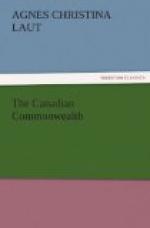It would be untrue to say that these investments have all been wisely made. One wonders, indeed, at what the purchasing agents were aiming in some cases. I know of small blocks in insignificant railroad towns bought for sixty thousand dollars, for no other reason, apparently, than that they cost ten thousand dollars and had been sold for twenty thousand dollars. The block, which would yield twenty per cent. on ten thousand dollars, yields only three per cent. on sixty thousand dollars. Held long enough, doubtless, it will repay the investor; or if the investor is satisfied with three per cent., where Canadians earn twenty per cent.—it may be all right; but Canadians expect their investments to repay capital cost in ten years, and they do not buy for profits to posterity but for profits in a lifetime.
Similarly of many of the r_an_ches bought at five dollars an acre by Americans and resold as r_awn_ches at twenty-five dollars to forty dollars to Englishmen. If the Englishmen will be satisfied with two and three per cent., where the American demands and makes twelve to twenty per cent.—the investment may make satisfactory returns; but it is hard to conceive of enormous tracts two and three hundred miles from a railroad bought for fruit lands at twenty-five dollars an acre. Fruit without a market is worse than waste. It is loss. When questioned, these English investors explain how raw fruit lands that sold at twenty-five dollars an acre a few years ago in the United States to-day sell for five hundred dollars and one thousand dollars an acre. The point they miss is—that these top values are the result of exceptional conditions; of millionaires turning a region into a playground as in the walnut and citrus groves of California; or of nearness to market and water transportation; or of peculiarly finely organized marketing unions. If the rich estates of England like to take these risks, it is their affair; but they must not blame Canada if their investment does not give them the same returns as more careful buying gives the Canadian and American.
Not all investments are of this extravagant character. Hundreds of thousands of acres and city properties untold have been bought by English investors who will multiply their capital a hundredfold in ten years. I know properties bought along the lines of the new railroads for a few hundred dollars that have resold at twenty thousand and thirty thousand and fifty thousand. It is such profits as these that lure to wrong investment.




